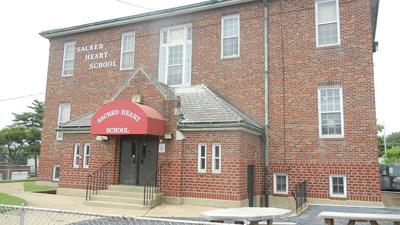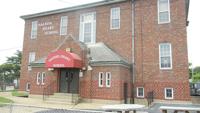A Twin Cities-area transitional housing facility to help people who are unhoused get back on their feet has moved one step closer to becoming a reality.
The Festus City Council voted unanimously July 28 to approve a conditional-use permit for Sacred Heart Catholic Church, 555 Bailey Road, in Crystal City to operate the transitional housing facility.
The church plans to tear down the former Sacred Heart School, which is across the street from the church. The school closed at the end of the 2005-2006 school year and merged with Our Lady Catholic School in Festus.
Once the old Sacred Heart school building, at 201 Brierton Lane, in Festus is demolished, plans call for it to be replaced with a new building.
The project is a collaboration between Sacred Heart Parish of Festus and Crystal City, Catholic Charities and the Archdiocese of St. Louis.
The new building would cost an estimated $1 million. Of that, $585,000 would be covered by a grant from the Affordable Housing Task Force of the Annual Catholic Appeal. The other $415,000 would be covered with grants, donations and other funding the church is attempting to secure, said Chris Auchly, the church’s facilities director and business manager.
New building
Sacred Heart previously considered using the parish’s old convent for a transitional housing facility but found the costs to bring the two-story house up to code prohibitive, Auchly said. So, Sacred Heart started looking at other options and decided the old school had the most potential.
However, church officials determined it was not feasible to use the old three-story, 21,000-square-foot school building as is and it needed to be torn down and replaced with a new building, he said.
“The school is almost 100 years old. It’s got good bones, but it’s not been kept up very well lately, and to bring it up to code would be cost prohibitive,” Auchly said. “There’s no elevator, and there’s no floor that’s not accessible by less than 11 steps.
“The windows are original windows and need to be replaced. The roof needs to be replaced. And because it’s an old building, of course, there’s lead and asbestos, so those would all have to be mitigated. Just to rehab that building would be twice the cost of what this project is.”
Auchly said the old facility would be replaced with a new approximately 4,100-square-foot facility called Caritas House. Caritas means love of humanity and charity in Latin.
The facility is expected to house between 15 and 20 people. Residents would include men, women and women with children. Laundry, internet, showers, a communal living space and kitchen would be available to residents, he said.
Auchly said the facility would be built in such a way to allow for the addition of more living space if needed later. The grounds would include a public green space.
A growing need
When completed, the Caritas House would be the first transitional housing facility in Jefferson County and the third of its kind in the St. Louis region, with similar transitional housing centers available at Bridge of Hope Lincoln County in Troy and Life’s River in Washington, Auchly said. He said the Caritas House would be modeled after Bridge of Hope.
Auchly said homelessness has been a problem in the area for a long time, but it became more visible when an encampment of about 20-30 people who were staying at the Twin City Levee Commission property east of Walmart near Plattin Creek was cleared out last year.
The Army Corps of Engineers requires the Twin Cities to keep that area free of debris that could clog up nearby levee pumps. If items from an encampment, like trash, tents and other belongings, washed into the Plattin Creek during flash flooding, it could damage or destroy downstream levee pumps, which could cause many parts of the city to flood, city officials said.
Father Michael Lydon, the episcopal vicar of the southern vicariate of the Archdiocese, helped to start Bridge of Hope and is involved in the planning for Caritas House.
Lydon said caring for the unhoused has been a lifelong passion. When he was in the seminary more than 40 years ago, he joined Operation Night Watch, which eventually became Saints Peter and Paul Community Services that serves people who are unhoused to this day.
“It fired my imagination because I’ve always had a home. I’ve been loved and cared for my whole life by my family and others, and it just blew my mind that some people were without shelter,” he said.
Lydon said he believes community members will support Caritas House because they realize what a large issue homelessness has become in the area. He said he hopes that once the Festus transitional facility proves successful, it would incentivize more people, churches and businesses to get involved and donate to the cause.
He also said he hopes that eventually there would be enough funding to open multiple transitional housing facilities across the county.
“Bridge of Hope in Lincoln County has had a marvelous response from the community in getting kind donations from churches and community organizations of food, clothing, furniture, quilts, and all sorts of things that can help the homeless transition from their current place at the center to a place of their own. They also give dishes, glasses and stuff like that to help with the center itself,” Lydon said. “I’m hopeful that kind of community strengthening and support might be evident in Jefferson County as well.”
A new start
According to the conditional-use permit application, to be eligible for housing at Caritas House, residents would have to meet the following criteria: be 18 or older; be able to pay $260 per month for rent; be able to live well in a community; and be clear of felonies related to arson or sex offenses.
The application also said most people would be referred to Caritas House through a service provider, such as a mental health service, behavioral health service or homeless service. Once an applicant was referred to Caritas House, he or she would be placed on a wait list until the next available room opens up.
“These are folks who are vetted strongly for wanting to get out of homelessness. This isn’t just anybody,” Lydon said. “They’ve got to express a desire and have a track record of being clean from addiction.”
Lydon said the residential space is intended to be a short-term housing option for people who are unhoused and are working to get back on their feet and find safe affordable housing, with most residents staying between six and 18 months. Residents would have a month-to-month lease agreement and abide by community rules. While at the facility, residents would work with case managers to help them meet their goals to find a job, continue their education and attend to their mental and physical health needs.
Auchly said Caritas House hopes to partner with Mercy and Compass to offer mental health care services once the facility is open. He said a 12-step program with meetings would be available to residents as well.
Sacred Heart does not plan to move forward with the demolition of the old school building until all the funds have been raised for the new facility, Auchly said, but he hopes for construction to begin on the new building next year, either in late summer or early fall.
Festus City Administrator Greg Camp said the city supports the project.
“The city of Festus is proud of the approval and development of a transitional housing initiative set to break ground in 2026. This project marks a critical step forward in addressing homelessness and housing insecurity in our region. This collaboration between the Archdiocese of St. Louis, Catholic Charities and the Sacred Heart Parish reflects a commitment to providing pathways out of homelessness and ensuring that all residents have the opportunity to thrive,” Camp said. “We see this as not just building housing – it’s strengthening community safety, well-being and long-term economic resilience.”




